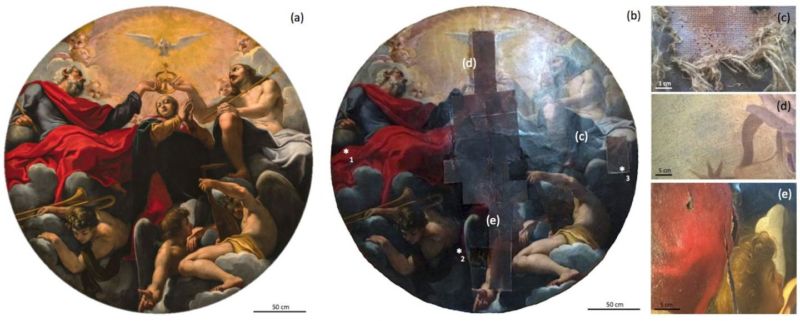via the New Statesman by Mishelle Thurai

GETTY
The gavel hit the soundboard with one swift movement marking the end of lot 388 in The Valuable Books and Manuscripts Sale on 11 July 2018 at Christie’s auction house. A watercolour, Charlie, Willie Wonka, and Grandpa Joe, had been sold for £50,000, more than three times its estimate (£10,000-15,000).
It was the highest ever price for a work by Sir Quentin Blake, whose career as an illustrator has spanned four decades. At 85 years old, he still illustrates with the same recognisable style that makes his work globally famous.
Continue reading
==============================
via ResearchBuzz Firehose: Kiona N. Smith for ArsTechnica
Microbes are everywhere, even between layers of paint on classic works of art

Enlarge / The middle image shows the painting as it now appears, with close-ups of four centuries of damage and wear on the right. The asterisks mark the locations of Caselli and her colleagues' samples.
A new study describes the complex ecosystems of bacteria and fungi that live and feast on a 17th-century painting—and how other species of bacteria may one day help art conservators fight back.
If you could zoom in for a microscopic look at an oil painting on canvas, you would see many thin, overlapping layers of pigments—powdered bits of insects, plants, or minerals—held together with oils or glue made from animal collagens. Many of those pigments and binding materials are surprisingly edible to bacteria and fungi. Each patch of color and each layer of paint and varnish in an oil painting offers a different microbial habitat. So when you look at a painting, you’re not just looking at a work of art; you’re looking at a whole ecosystem.
Continue reading
==============================
If we no longer seek virtue and salvation, we should blame the triumvirate of Machiavelli, Hobbes and Adam Smith.
via The New Statesman by John Gray

According to David Wootton, we are living in a world created by an intellectual revolution initiated by three thinkers in the 16th to 18th centuries. “My title is, Power, Pleasure and Profit, in that order, because power was conceptualised first, in the 16th century, by Niccolò Machiavelli; in the 17th century Hobbes radically revised the concepts of pleasure and happiness; and the way in which profit works in the economy was first adequately theorised in the 18th century by Adam Smith.” Before these thinkers, life had been based on the idea of a summum bonum – an all-encompassing goal of human life. Christianity identified it with salvation, Greco-Roman philosophy with a condition in which happiness and virtue were one and the same. For both, human life was complete when the supreme good was achieved.
Continue reading
==============================
via Boing Boing by Rusty Blazenhoff
The Making of "The Empire Strikes Back", the rare 1980 French TV movie documentary about the second film in the Star Wars trilogy, was considered lost until recently. Since clips surfaced a few years ago, it's been considered the "Holy Grail" for Star Wars fans. Directed by late director Michel Parbot, the hour-long film has now been found and posted on YouTube. Watch it while you can.
58 minutes of pure delight for fans!
==============================
via Interesting Literature
‘From Sunset to Star Rise’ is not one of the best-known poems by Christina Rossetti (1830-94), but it’s a real gem of a poem.
Continue reading
==============================
via Arts & Letters Daily: Adam Gaffney in The New Republic

NASA/Hulton Archive/Getty Images
A new book argues that life may be spread more widely through the universe than we think.
How did life begin? Two common answers come to mind. One is that, at some point, a deity decided to suspend the laws of physics and will a slew of slimy creatures into being. A second is that a one-in-a-trillion collision of just the right atoms billions of years ago happened to produce a molecular blob with the unprecedented capacity to reproduce itself.
Continue reading
==============================
via About History

The dynasty was founded by the Norwegian Viking Rollo, who received from the French king in 911 the territory of Normandy, which later became the duchy. As a result of the conquest of England by the duke William in 1066, the Kingdom of England passed under the authority of the Norman dynasty. The last representative of the male dynasty, Henry I, died in 1135 , he was succeeded by his nephew Stephen of Blois, also sometimes attributed to the Norman dynasty. After the death of King Stephen in 1154, the Plantagenet dynasty established itself on the thrones of England and Normandy.
Continue reading
==============================
By the late 18th century, up to 70% of the soldiers manning the ships of the Dutch East India Company came from outside the Netherlands
via the Big Think blog by Frank Jacobs
The Dutch still call it their Golden Age: in the 17th century, they built a trading empire that spanned the globe and propelled them to the pinnacle of power and influence in Europe. World cities as far apart as New York, Cape Town and Jakarta are all built on Dutch foundations.
But the Dutch Golden Age wasn’t all that Dutch. As these maps show, the crews manning the ships of the VOC, the Dutch East India Company, came from all over Europe, and indeed from all over the world.
Continue reading
==============================
via Boing Boing by Andrea James

The island village of Läsö off the Danish mainland has preserved houses built hundreds of years ago, when owners would thatch the roof with tons of seaweed.
Continue reading (and watch a short video)
==============================
via Interesting Literature
‘How happy is the little Stone’ is a delightful and delighted lyric about the simple features of the natural world, written by the prolific poet Emily Dickinson (1830-86). This poem is more upbeat than some of Dickinson’s more famous poems, which take on themes such as death and depression, so we thought it worth sharing here.
Continue reading
No comments:
Post a Comment